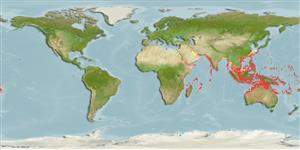分類 / Names
共通名の | 類義語 | Catalog of Fishes(部類, 種) | ITIS | CoL | WoRMS | Cloffa
Environment: milieu / climate zone / depth range / distribution range
生態学
海 関連する礁; 深さの範囲 0 - 100 m (Ref. 58652). Tropical; 30°N - 23°S
Indo-Pacific: Red Sea to South Africa (Ref. 35918) and to the Tuamoto Islands, north to the Ryukyu Islands, south to New Caledonia. Formerly known as Vulnerable (A1d+2cd) (Y. Sadovy) but now listed as Endangered in IUCN 2004.
Length at first maturity / サイズ / 重さ / 年齢
Maturity: Lm ?, range 52 - ? cm
Max length : 229 cm SL オス/雌雄の選別がない; (Ref. 9823); common length : 60.0 cm TL オス/雌雄の選別がない; (Ref. 5450); 最大公表体重: 191.0 kg (Ref. 9710); 最大記録サイズ: 32 年 (Ref. 51676)
背面の脊椎 (合計) : 9; 背鰭 (合計) : 10; 肛門の骨: 3; 臀鰭: 8. This species is distinguished by the following characters: body deep, its depth 2.2-2.7 times in standard length; dorsal profile of head straight to above eye, then becoming convex; adults develop a large hump on forehead that can protrude anterior to eye; anterior tip of head forming an acute angle; jaws and lips prominent, 2 strong canines anteriorly in each jaw; no enlarged tooth present of rear of upper jaw; D IX,10, continuous; A III,8; dorsal and anal fins of adults very pointed, reaching well posterior to caudal-fin base; pelvic fins of small fish reaching anus, extending beyond anal-fin origin in large adults; pectoral fins with ii unbranched and 10 branched rays; caudal fin rounded; lateral line interrupted below posterior portion of dorsal-fin base, with a total of 22-23 pored scales; scales reaching well onto bases of dorsal and anal fins; scales in front of dorsal fin extending forward to above centre of eye; cheek and opercle scaly; lower jaw without scales. Colour of body olive to green with a vertical dark bar on each scale above and behind pectoral fins; head of adults blue-green to blue with highly irregular undulating yellowish lines; 2 black lines extending posteriorly from eye. Juvenile coloration lighter to white with dark scale bars and prominent black lines extending posteriorly from eyes, as well as 2 lines extending diagonally up and back from eye and 2 diagonally downward on snout in front of eye (Ref. 9823).
Adults inhabit steep outer reef slopes, channel slopes, and lagoon reefs (Ref. 1602). They are benthopelagic at 2-60 m (Ref. 58302). They are usually solitary but may occur in pairs. Juveniles are encountered in coral-rich areas of lagoon reefs, where staghorn Acropora corals abound (Ref. 1602) and also in algae reefs or seagrasses (Ref. 48636, 41878). Adults rove across the reefs by day and rest in reef caves and under coral ledges at night (Ref. 31343). Primary food are mollusks, fishes, sea urchins, crustaceans, and other invertebrates. They are one of the few predators of toxic animals such as sea hares, boxfishes and crown-of-thorns starfish (Ref. 1602). They are oviparous with distinct pairing during breeding (Ref. 205). They are sold in Hong Kong live fish markets (Ref. 27253). This species is captured by hook-and-line and by spear, and is occasionally marketed for food. Juveniles are occasionally seen in the aquarium trade (Ref. 9823). Minimum depth reported taken from Ref. 128797.
Life cycle and mating behavior
Maturities | 繁殖 | Spawnings | Egg(s) | Fecundities | 幼生
Oviparous, distinct pairing during breeding (Ref. 205). Also Ref. 103751.
Randall, J.E., G.R. Allen and R.C. Steene, 1990. Fishes of the Great Barrier Reef and Coral Sea. University of Hawaii Press, Honolulu, Hawaii. 506 p. (Ref. 2334)
IUCNのレッドリストの状況は (Ref. 130435)
絶滅危惧 (EN) (A2bd+3bd); Date assessed: 30 April 2004
人間に対する脅威
Reports of ciguatera poisoning (Ref. 5374)
Human uses
水産業: 少数商業の; 水産養殖: 商業; ゲームフィッシュ: はい; 水族館・水槽: 商業
用具
特記事項
XMLをダウンロードして下さい
インターネットの情報源
Estimates based on models
Preferred temperature (Ref.
123201): 24.9 - 28.8, mean 27.5 °C (based on 580 cells).
Phylogenetic diversity index (Ref.
82804): PD
50 = 0.5078 [Uniqueness, from 0.5 = low to 2.0 = high].
Bayesian length-weight: a=0.01514 (0.01169 - 0.01959), b=2.97 (2.90 - 3.04), in cm total length, based on LWR estimates for this species (Ref.
93245).
栄養段階 (Ref.
69278): 4.0 ±0.61 se; based on food items.
Generation time: 27.5 ( na - na) years. Estimated as median ln(3)/K based on 2
growth studies.
回復力 (Ref.
120179): 低い, 4.5年~14年の倍増期間の最小個体群 (tm = 5-7; tmax = 32).
Fishing Vulnerability (Ref.
59153): High to very high vulnerability (74 of 100).
Nutrients (Ref.
124155): Calcium = 12.1 [5.8, 27.5] mg/100g; Iron = 0.416 [0.172, 0.952] mg/100g; Protein = 18.1 [13.7, 21.4] %; Omega3 = 0.0801 [, ] g/100g; Selenium = 63.5 [27.0, 158.4] μg/100g; VitaminA = 100 [16, 448] μg/100g; Zinc = 1.77 [1.00, 3.02] mg/100g (wet weight); based on
nutrient studies.
